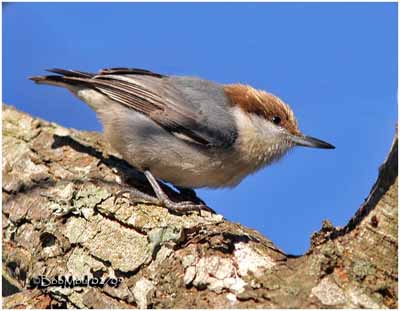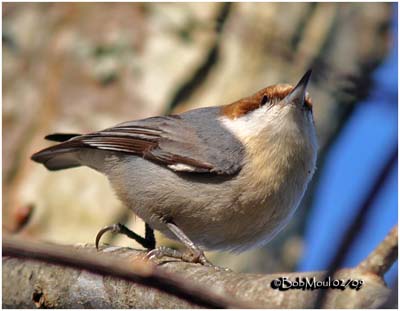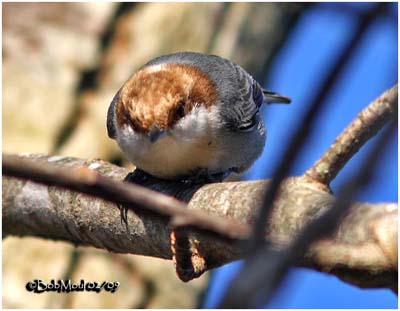
Brown-headed Nuthatch
Sitta pusilla
Passeriforme Order – Sittidae Family
BIOMETRICS:
Length: 10 à 11 cm
Wingspan: 16 à 18 cm
Weight: 10 g
LONGEVITY: Up to 5 years
DESCRIPTION:
Brown-headed Nuthatch has brown crown, bordered by narrow dark eye line. We can see a pale nape spot, contrasting with brown cap and blue grey upperparts. It has white cheeks, chin and throat. Underparts are buffy white. Flight feathers are darker blue-grey. Tail is dark blue-grey with white spots on outer feathers.
Bill, eyes, legs and feet are black.
Both sexes are similar.
Juvenile resemble adult but duller, with more grey and less brown, and it often lacks white spot on nape.

VOICE: SOUNDS BY XENO-CANTO
Brown-headed Nuthatch’s call is a high pitched repeated double note as a squeak. They are constantly chattering during breeding season. Notes resemble syllables “deut-deut-dend-dend”, not very musical, but not unpleasant too.
Contact call is a soft “tip” or “pit”. Alarm call is an explosive, nasal “ziu”, or more often “ziu-uu” with the second note repeated several times.
HABITAT:
Brown-headed Nuthatch is fairly common, and found in pine woodlands, in open and mature forests where periodic fires occur.
RANGE:
Brown-headed Nuthatch is resident from eastern Texas and extreme south-western Oklahoma, through the southern coastal states north to Delaware. Also in the Bahamas.
BEHAVIOUR:
Brown-headed Nuthatch forages in pines. It gleans from foliage, probes in crevices and is able to open pinecones. It also pries into crevices.
It may use flakes of bark as a lever or a tool, to pry up other bark to search for food. It keeps this tool and carries it from tree to tree. It also may use it as a cover to hide seeds.

Brown-headed Nuthatch joins mixed flocks in winter for foraging. They have to compete for food with Pine Warblers. They attack from each other to keep their preferred foraging areas.
Brown-headed Nuthatch roosts on tree cavity, or on pine branches. Breeding pair roosts in the nest before the eggs are laid, and during the nestling period.
Brown-headed Nuthatch is very active. It is often seen mounting, descending, and turning with a quickness of motion greater than most other birds. It probes each hole and crevice in the bark, as well as leaves and twigs where it finds food.
They are also seen on the ground, hopping and turning over dead leaves, searching for food.
FLIGHT:
Brown-headed Nuthatch has an agile and rapid flight.
REPRODUCTION:
Brown-headed Nuthatch’s nest is located in pine tree, in a hole in a stump, high in trees, in natural or abandoned cavities, or in holes excavated by male and female.
Nest is made with grass, feathers, pine seeds “wings”, Spanish moss, grass rootlets, fur and soft vegetation.
Female lays 4 to 6 speckled eggs. Incubation lasts about 14 days, by female, often fed by the male during this period. Chicks hatch altricial. Young fledge at about 18 to 19 days of age. They remain together after leaving the nest. They may take care for young of the second brood. Usually, they are young males or older offspring of the breeding pair.
This species produces one or two broods per season.

DIET:
Brown-headed Nuthatch feeds on insects and pine seeds. They consume small insects and their eggs, beetles, and spiders.
PROTECTION / THREATS / STATUS:
Brown-headed Nuthatch is threatened by habitat loss due to forest fragmentation, reducing breeding and foraging areas. Loss of mature pine forests has played a major role in decline of these populations.
Fr: Sittelle à tête brune
All : Braunkopfkleiber
Esp : Sita de Cabeza Castaña
Ital : Picchio muratore capobruno
Nd : Denneboomklever
Sd : Brunhuvad nötväcka
Photographs by Bob Moul
His website :
Nature Photography
Text by Nicole Bouglouan
Sources :
HANDBOOK OF THE BIRDS OF THE WORLD Vol 13 by Josep del Hoyo-Andrew Elliot-Jordi Sargatal - Lynx Edicions – ISBN: 9788496553453
FIELD GUIDE TO THE BIRDS OF NORTH AMERICA - National Geographic Society - ISBN: 0792274512
All About Birds (Cornell Lab of Ornithology)
What Bird-The ultimate Bird Guide (Mitchell Waite)